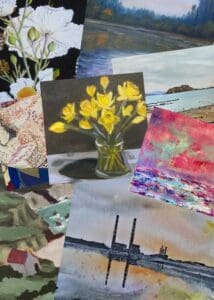Creative Exercises to Break Through Artist’s Block
Artist’s block is a common challenge that many creatives face at some point in their journey. It can feel like a wall that separates you from your art, leaving you frustrated and uninspired. However, the good news is that there are numerous techniques and exercises designed to help you break through this block and reignite your creativity. In this blog post, we’ll explore practical exercises that can help you reconnect with your artistic self and inspire new ideas. From free drawing to mind mapping and exploring new mediums, these strategies are intended to help you unleash your creativity and enjoy the artistic process once again.
Understanding Artist’s Block
Before diving into the exercises, it’s essential to understand what artist’s block is and why it happens. Artist’s block can stem from various sources, including self-doubt, perfectionism, external pressures, or simply feeling uninspired. Recognizing that this experience is normal and often temporary is the first step in overcoming it.
1. Free Drawing
One of the simplest yet most effective ways to break through artist’s block is to engage in free drawing. This exercise involves letting go of any preconceived notions or expectations and simply allowing your hand to move across the page. Here’s how to do it:
Steps:
- Gather your materials: You can use a sketchbook, loose paper, or even digital tools if you prefer.
- Set a timer for 10-15 minutes.
- Start drawing whatever comes to mind without worrying about the outcome. It could be abstract shapes, doodles, or even random patterns.
- Focus on the act of drawing itself rather than the result. Let your creativity flow freely.
Benefits:
Free drawing helps reduce anxiety about creating art and allows you to reconnect with the joy of drawing. It also encourages spontaneity and can lead to unexpected ideas.
2. Mind Mapping
Mind mapping is a visual brainstorming technique that can help you generate ideas and explore new themes for your artwork. This technique allows you to organize your thoughts and identify connections between different concepts.
Steps:
- Start with a central idea or theme in the middle of a blank page.
- Branch out with related ideas, keywords, or images, creating a visual representation of your thoughts.
- Use colors, symbols, or drawings to make it more engaging.
- Continue to expand on these branches, allowing your mind to wander and explore different possibilities.
Benefits:
Mind mapping encourages divergent thinking and helps you discover new perspectives or themes for your art. It can also clarify your thoughts and inspire new directions in your work.
3. Exploring New Mediums
Sometimes, stepping out of your comfort zone and experimenting with new materials can reignite your creativity. Trying a different medium can open up new possibilities and inspire fresh ideas.
Steps:
- Choose a medium you’ve never worked with before, such as charcoal, watercolor, acrylics, or digital art.
- Set aside time to play and experiment without the pressure of creating a finished piece.
- Allow yourself to make mistakes and learn from them. Explore techniques that are unique to that medium.
Benefits:
Exploring new mediums can help you break free from routine and provide a fresh perspective on your artistic process. It encourages innovation and can lead to the discovery of new techniques and styles.
4. Daily Creative Prompts
Using daily creative prompts is an excellent way to challenge yourself and keep your creativity flowing. These prompts can be simple phrases, words, or themes that inspire you to create.
Steps:
- Create a list of prompts or find resources online that offer daily art challenges. Websites like ArtPrompts.org provide a variety of ideas to get you started.
- Choose one prompt each day and dedicate time to create something based on that prompt.
- Don’t worry about the quality; focus on completing the task and letting your creativity take the lead.
Benefits:
Daily creative prompts keep you engaged and provide a structured way to produce art regularly. They can help you push through resistance and explore different themes or subjects.
5. Collaborative Art
Collaboration can be a fantastic way to reignite your creativity. Working with other artists can provide new insights and perspectives that you might not have considered.
Steps:
- Reach out to fellow artists or friends and propose a collaborative project. It could be a joint painting, mixed-media piece, or even an art exchange.
- Set some guidelines for the collaboration but allow for flexibility and creativity from all participants.
- Share ideas and techniques, and encourage open communication throughout the process.
Benefits:
Collaboration fosters a sense of community and can provide motivation and support. It also exposes you to different artistic styles and methods, inspiring you to explore new approaches.
6. Nature Walks and Observation
Sometimes, inspiration can be found in the world around us. Taking a walk in nature or observing your environment can spark new ideas and help clear your mind.
Steps:
- Set aside time to go for a walk in a park, forest, or any natural setting.
- Bring a sketchbook or camera to document your observations, whether it’s interesting shapes, colors, or textures.
- Allow yourself to absorb the beauty around you and take notes or sketches that you can reference later.
Benefits:
Nature has a calming effect and can help reset your mind. Observing the world with a creative eye can lead to fresh ideas and a renewed sense of appreciation for your surroundings.
7. Art Journaling
Art journaling combines writing and drawing, allowing you to express your thoughts and emotions creatively. This exercise can help you process your feelings and unlock new ideas.
Steps:
- Choose a journal or sketchbook dedicated to your art journaling practice.
- Set aside time to write freely about your thoughts, feelings, or experiences related to your art.
- Incorporate drawings, doodles, or collage elements alongside your writing.
Benefits:
Art journaling provides a safe space for self-expression and exploration. It can help you uncover underlying emotions and thoughts that may be contributing to your artist’s block.
8. Set Goals and Challenges
Setting specific artistic goals or challenges can motivate you to create and push through blocks. These goals can be short-term or long-term, depending on your needs.
Steps:
- Identify what you want to achieve creatively. It could be completing a certain number of pieces, learning a new technique, or participating in an exhibition.
- Break your goals down into smaller, manageable tasks.
- Track your progress and celebrate your achievements, no matter how small.
Benefits:
Setting goals provides direction and focus, helping you stay motivated. It also encourages you to hold yourself accountable and fosters a sense of accomplishment.
9. Visit Art Galleries and Exhibitions
Exposure to other artists’ work can be incredibly inspiring and can reignite your passion for creating. Visiting galleries and exhibitions allows you to see a variety of styles and techniques.
Steps:
- Make a plan to visit at least one exhibition or gallery each month.
- Take notes or sketches during your visits, focusing on what resonates with you.
Benefits:
Surrounding yourself with art can spark inspiration and provide new ideas for your work. It also allows you to connect with the art community and gain insights into current trends.
10. Digital Detox
In our increasingly digital world, taking a break from screens can help clear your mind and reduce distractions. A digital detox can provide the mental space needed to reconnect with your creativity.
Steps:
- Choose a period for your digital detox, whether it’s a few hours, a day, or even a week.
- During this time, engage in offline activities like drawing, painting, or reading.
- Use this time to reflect on your artistic goals and aspirations.
Benefits:
A digital detox allows your mind to rest and can help reduce anxiety and overwhelm. It creates space for new ideas and insights to emerge.
Conclusion
Breaking through artist’s block is a journey that requires patience and experimentation. By incorporating these creative exercises into your routine, you can reignite your passion for art and discover new avenues for self-expression. Remember that creativity is not a finite resource; it can be cultivated and nurtured through practice and exploration.
By embracing these techniques and exercises, you can navigate through artist’s block and continue to grow as a creative individual. Remember, the most important part of being an artist is to enjoy the process and stay curious.
*For collaborations, art features, or inquiries, please contact us at in**@**********rt.ie. Don’t forget to follow us on Instagram, Facebook, Twitter.
Disclaimer: The views and opinions expressed in this article do not necessarily reflect the official policy or position of Irish Artmart.
Irish Artmart – Your Gateway to Artistic Excellence.
Tips to Express Your Creative Vision – Irish Artmart Podcast




